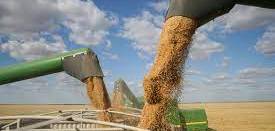
This article was published in the World Economic Forum
- The war in Ukraine has drawn attention to Russia's global exports.
- Russia is a key supplier not only of oil and gas, but also of wheat, metals and fertilizers.
- Sanctions against Russia have led to a sharp rise in the prices of various commodities.
Russia's response to international sanctions following its invasion of Ukraine was to order a halt to exports of more than 200 products. But what exactly does Russia export and where do its shipments go?
Media attention has focused on Russia's role as a major supplier of oil and gas, but the country also exports many other commodities and products.
Crude oil is Russia's biggest export , accounting for $123 billion of its export revenue, according to 2019 data. Refined petroleum — things like gasoline and diesel — came next at 66.2 billion, gas at $26.3 billion and coal at $17.6 billion.
But Russia is also the world's largest exporter of wheat, generating $8.14 billion in sales in 2019. It's also a big exporter of semi-finished iron – including iron bars and other items used to make iron products – with sales of just under $7 billion in 2019, and a major supplier of nickel ($4.03 billion) and nitrogen-based fertilizers ($3.05 billions of dollars).
Energy and raw materials, such as metals, are actually exempt from the export ban , although Bloomberg quoted Moscow as saying it had suspended timber exports "to states that take hostile action." against Russia. The ban also covers telecom, medical, automotive, agricultural and electrical equipment .
Russia: a commodity superpower
In terms of raw materials, Russia is alsothe second largest exporter of cobalt , one of the key elements used in the manufacture of rechargeable batteries . It is also the world's second-largest supplier of vanadium , which is used in large-scale energy storage and in steelmaking.
The country is the sixth largest exporter of gold, accounting for 4.4% of global supply, and the 10th largest supplier of lead.
Russia accounts for 10% of the world's nickel supply, which is used to make stainless steel and vehicle batteries. The price of nickel soared 250% in one day over fears of sanctions hitting supplies, and the London Metal Exchange even suspended trading in the metal due to the unprecedented price increases.
Russian platinum exports account for 12.3% of world supply , and the country is the world's fourth largest exporter of tungsten . The country also supplies smaller amounts of manganese (which is used in the manufacture of glass, beverage cans and as a paint pigment) and zinc (used in the manufacture of car bodies).
Russia covers around 3.5% of global copper demand, and copper prices have reached record highs this month.
Who buys Russian exports?
China is the main destination for Russian exports , with 14.9% of the total by value in 2020. Next comes the Netherlands, whose 7.4% share is largely attributable to oil and gas imports .
Other important commodity export markets for Russia include the United Kingdom, which in 2020 absorbed 6.9% of Russia's total exports by value (worth $23 billion) , Germany (5.5%) and Belarus (4.7%).
What does the invasion of Ukraine mean for wheat supplies?
Russia also exports significant amounts of grain and has imposed a halt to grain shipments to its neighbors in the Eurasian Economic Union until the end of August to "maintain stability in the Russian market".
Russia and Ukraine together account for nearly a third of the world's wheat supply , and world wheat prices are at record highs due to the impact of war on shipments.
The two biggest buyers of Russian wheat exports are Egypt, the world's largest wheat importer , and Turkey. However, with Black Sea ports closed due to the conflict, the two countries are likely to import less from Russia in 2022, according to the US Department of Agriculture.
Written by
Douglas Broom , Senior Writer, Formative Content
Posted on 2022-03-21 06:00








Comments